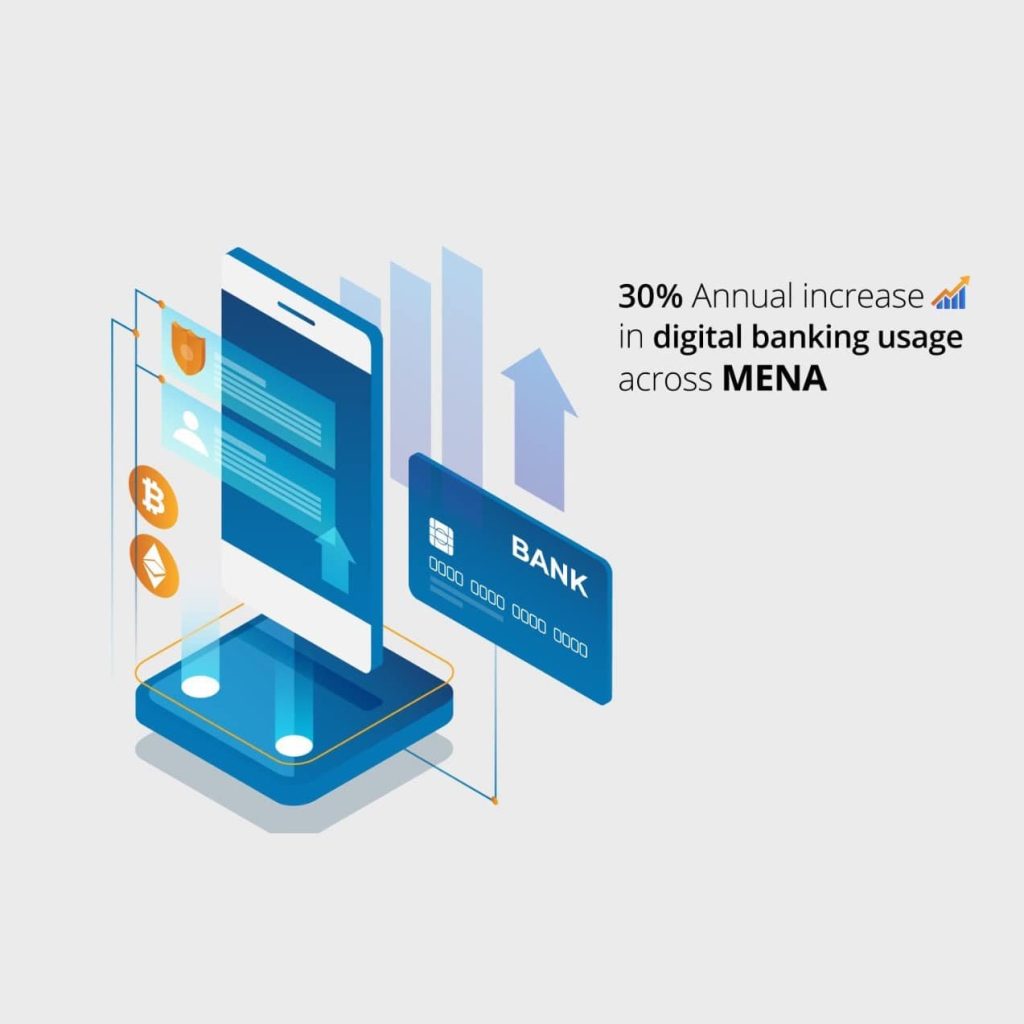post covid19 paradigm: evolution of digital banking in mena

The Covid-19 outbreak is imposing a significant threat on the banking sector, driving credit risk, and imposing cost-cutting initiatives and branch closures. Despite the uncertainty, banks in the MENA region are moving faster than ever towards digital transformation.
Governed by agility, flexibility, and cloud-based systems, fintech innovative solutions are made to withstand the impact of the outbreak. Would this prove as an opportunity for traditional banks to get rid of their customary practices and move into digital banking?
Emerging Technologies influencing Digital Capabilities
From digital wallets and mobile payment platforms, the customer’s need for seamless transactions can be met without having to step a foot in branches. Online services such as live chats, account opening, interactive teller machines (ITM), and bill payments, alongside many other mobile banking features, can be efficiently implemented by integrating cloud-based systems and trusted APIs to the bank’s core system.
How banks should lead onward in their Digital Transformation
1. Digital Novice (me-too digital): Traditional Banks, could add a Digital Front-end to supplement their existing core system; this would help target the customer need for hyper-personalized solutions in real time with utility services as a differentiator, such as online balance inquiry, real-time payment transactions, and bank’s product portfolios. At this stage, the incumbent bank can leverage mobile capabilities, remote banking support, and in some banks Instant issuance as a case for on-spot on boarding.
2. Vertical Integrator: The Greenfield Approach, offers banks the opportunity to leverage their assets (customer base, funding, card management system) to offer technology-driven platforms that are scalable, variable in costs, and can swap components from legacy systems to meet customer & organizational need for digital experiences. Meaning, to create Application Program Interfaces (APIs) driven infrastructure & architecture in which their core operating systems and cloud-based systems can co-exist. A user case, would be Bank Audi’s Novo branch that offers Interactive teller machine services and automated loan services. This can benefit both the digital-first customer and employee, as they both experiment with the new services and pass on the culture of digital-first banking solutions.
3. Horizontal Integrator: Digital financial capabilities are widely spread, with the MENA fintech sector growing at a 30% compounded annual rate ; banks could make use of readily available propositions from key industry providers, and connect to their issuing or acquiring network. By connecting to these providers, banks can leverage the use of digital financial services among its customers and employees. Creating an easy one-stop access to financial products & ability to address multiple financial needs on an Omni-channel banking platform; the bank can own the payment platform, integrate the technology, or embrace broad partnerships.
What Infotec Systems proposes
No matter the game plan, banks need the right partner to raise their capabilities and ensure their transformation journey is met with innovative payment solutions and flexibility at every stage of the way
Approach 1:
Focus on customer interaction, and identify reasons why customers visit the branch, and address those reasons by developing a user-friendly digital front-end, such as a mobile app. Efforts from banks in the MENA region involve building a digital-layer above the core banking services model with user-friendly interface, to allow a modernized access to essential functionalities, such as checking in real-time, account balance, bill payments, and online chat support.
Approach 2 (Playing Catch-up):
This approach has witnessed more user cases; it involves modernizing aspects of the product and transaction processing layer, where banks would identify high-priority customer needs and build modern integrations and information layers to be able to leverage new functions and features for product improvement.
An example would be integrating an Omni-channel card management system, were you will be able to launch several business models on the same platform and take less lead time to launch new products. The back-end system of the bank should be mature and modern enough to handle being fractured one function at a time.
Approach3 (Baas):
Following this approach comes from the bank’s motivation to entirely switch off from legacy, but this case is yet unclear, as infrastructure and regulatory policies seem unready. Therefore, banks run towards offering banking as a service, and leverage existing financial technologies in the market for their own interest. Banks view this as a disciplined approach towards untangling core system issues; the front end capabilities can seem doable, but the core functions would be a hurdle if the core banking system remains unchanged.
An example would be, integrating a third party app that can deal with anywhere and anytime payments, such as Altpay, with enabling technologies such as artificial intelligence or cloud-based systems to be offered as a new alternative to the core banking system.
“The Payments ecosystem is endorsing the latest trends in the new payments processing platform (NPPP) such as ALTPAY: Digital Commerce Gateway, that can dynamically manage Smart Android POS terminals; it’s also as a game changer for the acceptance platforms, driving a whole new seamless customer experience, and enabling the digital payments to be more secure and frictionless.” Mohamad Al Oweini- CTO Infotec Systems.
Conclusion
The Covid19 pandemic might have accelerated the digital scene across the banking industry. Yet, a remainder of unknowns on how traditional banks will respond still exists, but there appears to be broad consensus around increased adoption of digital banking solutions across the banking sector; perhaps because the direction of digital disruption is more clear, and the technological capabilities are there.